Cover Story
A Role Model, Innovator and Preserver of Heritage
A wise woman once said, “ When I hear people say I am not a feminist, I wonder, if they have understood the meaning of the word. All feminism means, is asking for women's rights. Feminism for a woman simply means asking for what is already hers”
ANIKA HOSSAIN
Photos: zahedul i khan
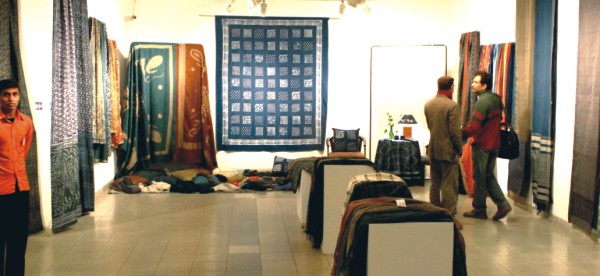
Products made of natural dyes on display.
The person, who spoke these words, sets a shining example of the success women can achieve not only in the corporate world, but in social services and within the walls of her own home. This woman, is none other than Ruby Ghuznavi, the managing director of Aranya - a pioneering contributor to the revival and marketing of natural dyes, a founding member of Karika which is the first craft making organisation in Bangladesh, a founding member and former president of the National Crafts Council of Bangladesh (NCCB) and currently, Covenor of the Committee on Natural Dyes (World Craft Council- Asia Pacific Region). She is a member of Naripokkho, a women's activist organisation, a trustee of Transparency International in Bangladesh and the former Country Delegate of Terre Des Hommes, a Swiss NGO protecting child rights. To top it all off, Ruby Ghuznavi is also a mother of two and has a superbly successful family life.
Born in Faridpur, to a father who was a civil servant at the time, Ruby Ghuznavi left Bangladesh at a very young age, for India. Her father was based in Kolkata as an ICS judge, where she and her eight brothers and sisters completed their schooling. In 1950, post partition, Ruby and her family migrated to the then East Pakistan. “ There were still too many riots going on. My mother was a widow with nine children to take care of, so times were very hard,” says Ruby. She enrolled in Chittagong College and completed her degree in Economics at Dhaka University.
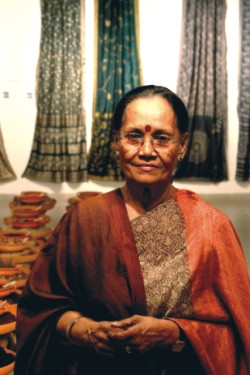 |
Ruby Ghuznavi- the woman behind the colours. |
Her interest in traditional Bangladeshi craftwork was sparked by inspirational people in her life, such as Kamla Devi Chattopadhyay a pioneer in the revival of natural dyes in Bangladesh, renowned artist Zainul Abedin and Rasheed Chowdhury. "Kamla Devi has been responsible for a lot of craft development, she was actually working with Gandhi for a while, so by the time I met her she was in her eighties. But the person who truly inspired myself and my contemporaries, Hamida Hossain, Parveen Ahmed and many others was Joynul Abedin bhai who had been collecting crafts from all over the country at the time," shares Ruby.
In 1973, these crafts were displayed in an exhibition, the success of which made Ruby realise that they could be marketed to the general public. With enough encouragement from Kamla Devi and her friends, in 1990, Ruby decided to set up a fair-trade micro enterprise specialising in crafts made from natural dyes. Thus started her journey with Aranya.
The journey has not been an easy one and many obstacles had to be overcome. " The early years were very exciting. We started Aranya as a research and development project so all of us knew very little at the beginning, about natural dyes. There were ten of us altogether and we started experimenting with just about every plant and every flower we could think of. We invited three Indian experts to help us. We would each discover a different colour, either on purpose or sometimes just accidentally, and would have to wrack our brains trying to retrace our steps. In those days we had to be very careful and document exactly what we were doing each time we made a new colour," remembers Ruby.
The main problem they faced back in those days was trying to convince crafts people to work with them. Bangladeshi tantis (weavers) usually do not make their own yarn, they buy coloured ones available in the market and this proved to be a problem for the Aranya group. " We have not been able to convince people who make dyed yarn to use natural dye, the reasons being it is labour intensive and most producers consider using natural dyes to be a backward process. According to them, the world is progressing, and they want to use modern materials to make their products rather than go looking for colours in the bushes" states Ruby.
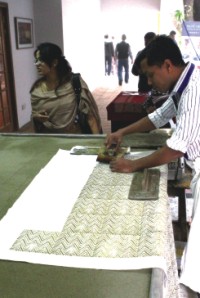 |
Making prints with natural dyes. |
The war of 1971 had left many women heading families, who knew how to make kanthas (blankets) and all kinds of handicrafts, the trouble was convincing them to do this on a commercial level. "When we were involved with Karika, which was the first crafts marketing organisation, we were visiting many different places around the country, searching for craft work. Back then, we decided that wherever we would go, we would ask who the artisans were and where to find them and the local people would always direct us. We did not have to teach anybody the skills, they had grown up doing this kind of work and had it in them. The only thing we needed to work on was product development. The kanthas that these women made were gifts for family members and guests, to wrap the Quran or the Geeta, but they were not for sale. We had to convince these people to make more saleable products such as saris, shawls, and pillow and cushion covers. At first they were sceptical about whether anybody would buy them, but we guaranteed them a market and good value for what they produced. I think that is where our main contribution has been," Ruby states.
These problems were solved to a certain extent when the crafts people saw the collection of colours made from natural materials and the number of orders being placed for their work. They realised their products could be marketed. The jamdani sari weavers also realised it was more profitable to work for Aranya and make the saris in less than two and half to three months working with other weavers than to spend a year working alone on a single product.
The village women, who made kanthas and did other stitch work in their free time were somewhat easier to convince, and through Aranya, Ruby managed to touch the lives of many. "These women needed a source of income. They already had the skills. There is a woman with whom I have worked for thirty years now. All I have to do is show her some pictures of antique threadwork and designs from the olden days and tell her to make her own version of these designs. Her pieces are absolutely exquisite! This is the wealth of knowledge and skill we were hoping to inherit. Some people feel that we have commercialised kanthas and think they should be left alone. I had to make a decision then, and I asked myself, do I keep this tradition pure? If I did that then it would take six months to a year to make a single kantha, making it difficult to market it, and these women need the money now. Selling their crafts is the only way in which these women can get money directly. When she raises cattle or grows vegetables and fruit, she needs her husband or her son to sell them for her, and more often than not, she will not get money back from them. If she is very lucky she may get some of it but it is unlikely. When these women get paid for their handiwork, we have found that they always re-invest it into their families. The first thing they do is send their children to school, and then with the remaining amount they buy cattle or land. So you see, I prefer to support this, if I have to choose between craft purity and improving their quality of life," she opines.
Ruby and her group at Aranya worked hard to ensure that the children working for these craftspeople who ran small karkhanas (factories), especially those under the age of thirteen, received an informal education and worked reasonable hours. She worked with Karushilpo Parishad and BRAC and set up schools specifically for these children. She stresses on how important it is for their parents to be more responsible and aware of the kind of work their children are being made to do.
 |
A common misconception is that natural colours are usually dull. Aranya has created 30 different colours, both bright and pale and they are all beautiful. |
Another somewhat interesting problem the group faced was related to religious beliefs and superstition of these crafts people. "Most of these women are Muslim, but we have some Hindu women working with us as well. The Muslim women would only make geometric or floral patterns. When we asked them to sow on some birds, animals or humans for a change, they said it was forbidden in the Quran to do so. As a solution, I asked them not to worry and said Allah can see that I am the person, for whom they are doing this, so the responsibility and consequences will be borne by me and they will be forgiven," laughs Ruby, " They in turn would offer to sew the body of the animals and people, but request that I sew on the face, to which I would say, I would if I had the talent."
Their most pressing problem, which continues till today, is getting good prices of their products. High prices for these products reduce the demand for them in the market. According to Ruby, the high prices are a result of their labour intensive production process. " It took me years to realise, that when making jamdani saris, the weavers count the threads each time, so if two people work on one sari together, it will take them about three months to complete it, if they want to make a very good jamdani," says Ruby. It is this time, and often, tedious labour that make the prices go up. “Unless you see with your own eyes, the amount of work that goes into making kanthas, jamdanis or even print work, you cannot understand why these products cost so much. People will always tell me that so and so is charging much less for similar products, but the difference is, say for example, on a printed material, ours are printed evenly throughout, while the ones that cost less will have at least ten inch gaps between their blocks. That way, they can make six saris a day while we only make three," she explains.
"I used to wonder about the prices of some craft work too. I once went to Dhamrai and saw a plain bowl with no design on it, which was quite costly and I wondered why that was. Years later when I went back and met the crafts people who made similar bowls, I saw that their hands were blackened, burned and hardened from touching hot brass year after year when making these simple, but beautiful bowls. They used no measurements, but the bowls were perfectly geometrical. It is then that I understood why they cost so much, because of the tremendous time and hard work that goes into producing them," she continues.
According to Ruby, fewer women wear saris these days especially women from the current generation. They do not even understand what a real jamdani looks like, which is why they are reluctant to spend twenty, thirty, forty thousand taka on these saris. " Jamdanis were never meant for ordinary people. They have always been high value products meant for special occasions. I advice people to buy one or two very good ones, with small, intricate work on them, instead of ten cheaper ones with large patterns which are not half as attractive and take one month to make instead of four. I know not everyone has forty thousand taka to spend on a sari, but some people do and they shop all over the world. They are our targeted clientele. If we cannot find people to buy our products, fine jamdanis will be lost to us forever," she says.
"Nowadays, many crafts people, who do not get the right value for their products, move away from their villages and come to Dhaka to work as day labourers and rickshaw pullers and to me that brain drain is far more damaging and a greater loss than a Phd student moving abroad. That is why we must give our artisans and craftspeople the true value for their work," she opines.
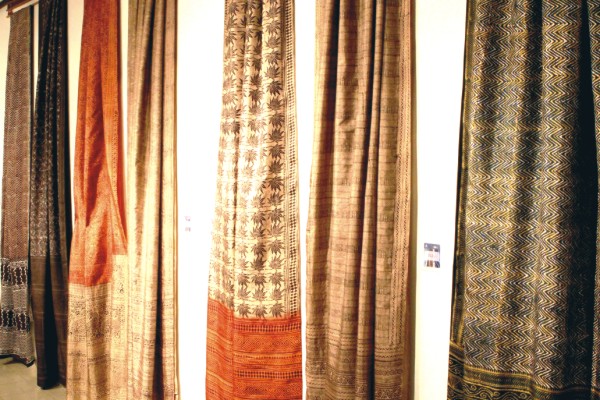
Blocked silk saris made from natural dyes.
Another damaging problem they are facing is designer intervention. "Designer intervention in product development is great, but not when it messes with jamdani designs,” says Ruby. Some designers get rid of the par (border) while others remove the anchal. When they do this, the craftspeople get confused and start thinking this is what people will buy. In my opinion, without a par and an anchal, a sari is not complete. I can't imagine a jamdani without them. Some people have started to put other designs, such as cutwork and appliqué on jamdanis and when I see that, I don't know whether to scream or weep. Perhaps I should do both! I know one designer who has put the par of a Mirpur kathan on a jamdani and vice versa and this was her idea of design. I think it is fine to put karchupi, cutwork and appliqué on printed saris. They can cut them to pieces if they want, but not a jamdani! For me this is craft impurity," she continues.
According to Ruby, the National Crafts Council is having a discussion with producers who are experimenting with jamdani designs to understand their point of view and also explain to them that jamdani and kanthas are unique to Bangladesh and must be preserved in their traditional forms. "The media can play a role by stressing on the need to maintain traditions in their pure form when developing them to fit contemporary needs," says Ruby.
Ruby also notes the misconceptions around natural dyes, which have affected the market for them. "Some say they are dull colours or that they are colour-fast, but there are all kinds of natural colours, both bright and pale, and they are all beautiful. They are also not colourfast, if they were we would not sell them. People buy enough chemical dyes, which are colourfast. The fact of the matter is, it is not the dye's fault, it was badly handled. We just have to be careful with our clothes and not soak them in detergent for too long, or leave them toasting in the sun for hours. The brightest of chemical dyes will fade under the scorching sun. There is a soap called Lisapol, which can be used on these products to preserve their colour. For jamdanis, Woolite or shampoo can be used if one can afford it."
Ruby believes that promoting natural dyes is an endeavour that should have been taken up on a larger scale by NGO's. " I think this is a job that developmental organisations should have taken up whole heartedly, because there is an ecological side to it. These dyes are environment friendly and non-pollutant and can generate more income because they are labour intensive. We have worked for the last thirty years to prove the commercial viability of this product. Now this project is badly in need for expansion, which I cannot handle alone. That is why I have handed it over to Bengal Foundation, because they have the resources to do so. Bengal has promoted arts and crafts in the past and I believe they will maintain the purity of natural dyes. I will stay on as a consultant, but will be a lot less involved. If I get any bright ideas for new designs, I will definitely be sharing it with them. I thought natural dyes would die with me, but now there is hope,” smiles Ruby as her journey with Aranya comes to an end.
Although Aranya has been Ruby Ghuznavi's passion for the past twenty years, it was not the only project this dynamic woman had undertaken. Shortly after the liberation war, thousands of children had been left abandoned and homeless on the streets of Bangladesh. Some were orphans, while others had been separated from their families. When the famine of '73 hit, the government opened a soup kitchen for them and left them there, as they could not afford to feed so many mouths. It was then that this Swiss NGO, Terre Des Hommes, started this project. They set up children's centres in four or five places.
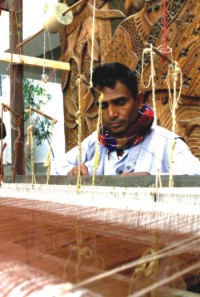 |
If our crafts people do not get the right value for their hard work, traditional crafts will be lost forever. |
"I was teaching at the time and working with Karika, which involved travelling around the country, quite a bit, when they approached me with this. They told me it was a part time job and that I would not have to give up my other work for it. I agreed and I absolutely loved it. My work with the NGO involved educating the children. The founder of this organisation was a great fan of play and music, so less time was spent on books and more devoted to hours of drawing, painting, different kinds of artwork and learning to play musical instruments," says Ruby.
"By the time the children reached the age of 12 to 14, they would complete their high school education and go into vocational training such as carpentry, weaving and a host of other options. I was the head of this organisation up until the 90's, so basically I was working two full time jobs, but it was an adventure for me which I enjoyed thoroughly," she continues.
After working with children for many years, Ruby moved on to join Naripokkho, which is a women's rights organisation. " At Naripokkho, we deal with legal concerns which women have with regard to property, domestic violence etc. We have not eradicated domestic violence, but we have documented it, because unless you have enough data, it is very difficult to work with these cases. Now, there is a whole movement against domestic violence, and laws are being created to prevent it, which I think is a result of a joint effort of many women's rights organisations and the Uniform Civil Court," says Ruby. One can tell from the passionate way she talks about her work with Naripokkho, that she feel very strongly about these issues.
Ruby believes that the discrimination between men and women begins from an early age, and it begins from home. Parents tend to be over-protective about their daughters, while they raise their sons to be more independent and strong. Girls are viewed as a liability from the moment they are born and they never learn to protect themselves. According to Ruby, uniform laws alone will not rid us of this problem, because it is the cultural, more than legal barriers, which cause them in the first place. Thinking of women as the weaker sex, is a mindset which has been passed down for generations, for centuries. "We need to work together to change this mindset, even if it takes us a few more centuries to do so," says Ruby. "Parents must be more open minded and treat their children equally. They must bring up their children in a way that makes them confident and independent. They must sensitise their sons, to these issues so they do not think of themselves as superior to the opposite sex," she opines.
"I remember Begum Rokeya back in the day had the guts to say, if men have problems with women on the streets, they can stay at home, why should we be put in purdah? That still applies today. When I hear about stalking and eve-teasing, it makes me furious. Whether it is acid violence, or the sexual harassment of school children, I believe there should not only be strict laws against these crimes, but awareness, sensitisation and education in regards to these matters should begin at home," she states. " I am proud of the fact that women today have far more mobility and can work and move around on their own, but there is much more work that needs to be done in regards to women's rights."
Ruby Ghuznavi has lead an exemplary life, but what enabled her to become captain planet and superwoman fused into one, was the love and support of the ones closest to her heart-- her family. Despite her busy life, she managed to spend time with her husband and two children, and is very close to them. " I must say I have the most incredibly supportive family. My husband would always support me wherever I wanted to work, and because he had a good job, I could always do voluntary work without having to worry about finances. My children, once they grew up, took an avid interest in what I do. They travelled with me to Chinmari and Kurigram, on my quest for craftwork and spent quality time with me on these trips, learning about what I do. They supported my work with natural dyes and enjoyed helping me when they could. I think this made a huge difference in my life. I believe that letting you work, alone, is not enough, your family has to be there during the tough days, when you feel down and hopeless and tell you everything will be alright, and my family has given me that," shares Ruby. " My son works with me now and my daughter writes and does development consultancies. My kids worry about me because I have had a heart stent done recently, but I have told my doctors and my family that they have to let me do what I want until January, until I hand over Aranya safely to Bengal Foundation. After that I will change my lifestyle. Right now, I eat, sleep and dream about Aranya. Even when I travel to places like Norway and Malaysia, I keep thinking to myself about what I can do in these countries that will help my business, so handing it over will be a load off my mind," she sighs, not without a hint of sadness.
Aranya may become a part of Bengal Foundation, but Ruby's work with colours will not stop there. The World Crafts Council has set up a natural dye programme, which she will be heading. They are currently setting up training and research centres in the Asia Pacific Region. Ruby plans to be more involved in the development and training aspect of this project rather than the business side of it. After years of teaching, training, activism, environmental work, and introducing traditional Bangladeshi crafts to the world, this energetic, charismatic, incredible woman has finally decided to take some time for herself. She would like to travel, spend more time with her family, read more and maybe someday even write a good book on jamdanis.
Women in Bangladesh are desperately in need of role models, who will give them the inspiration and confidence to set out to achieve all that they dream of. Even today, although women have started to take up their rightful place in society, many restrictions still remain, holding them back from all that they can be. Ruby Ghuznavi is one such role model who inspires women and men, to work towards changing the mindset of our society and preserving our traditions and culture in their truest form.
A Master Crafts Woman
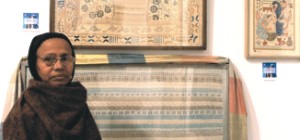 |
Latifa Begum |
Latifa Begum was a widow with four little daughters when she met Ruby Ghuznavi. Lafita had sewn a wall hanging for one of her former employers, which Ruby happened to come across. She took an interest in Latifa's work and asked her to make a piece for her. Thereafter, she was so impressed with the finished product that she had this piece displayed in an exhibition. Latifa Begum won first prize for her piece, in all of Bangladesh. She realised her craft was in demand, and she has been working with Ruby for 25 years since. "It was very difficult for me to to work with four little children to take care of alone. I could not leave them at home by themselves, so at the time, it was very helpful for me to get orders through Aranya and work on them from home. Nowadays, it is difficult to get the true monetary value for all the hard work we put into our products, but Ruby apa ensured I got the best possible price for them. The money I got, helped me with household expenses as well as my daughters' education. They are all college graduates now and two of them have even completed their masters. They all work as teachers in high schools. I managed their wedding expenses with this income as well," says Latifa. "Ruby apa has helped me in many ways, she even bore all my medical expenses after I had a stomach surgery. I owe her my life," she shares.
Latifa Begum specialises in threadwork, on shawls, kanthas, bedcovers, pillow and cushion covers, wallets, saris, panjabis etc. She measures with her hands and comes up with unique, intricate designs all on her own. She has won many awards for her work with Aranya and was hired as a trainer by Kumudini where she taught twelve thousand women her threadwork skills. Her work was exclusively featured in an exhibition at the Commonwealth Institute of London, where she earned money and recognition. Like Latifa Begum, there are many other women whose lives were touched by Ruby Ghuznavi and changed for the better. They will forever be grateful to her.
Copyright
(R) thedailystar.net 2010 |
| |
